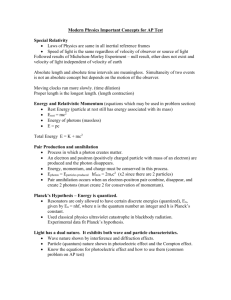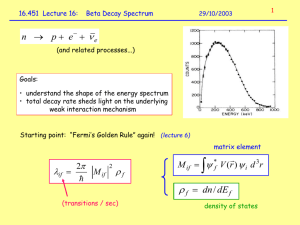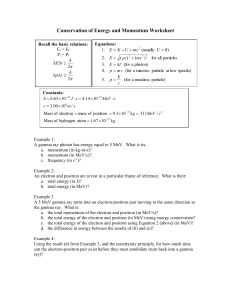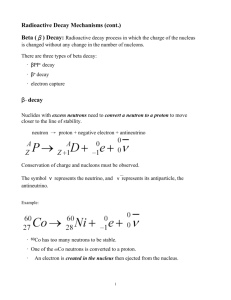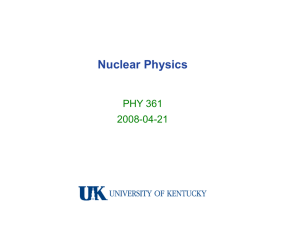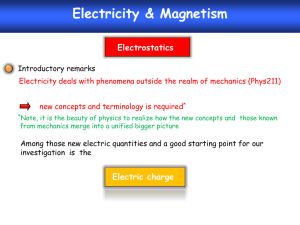RELATIVISTIC MOMENTUM AND ENERGY
advertisement
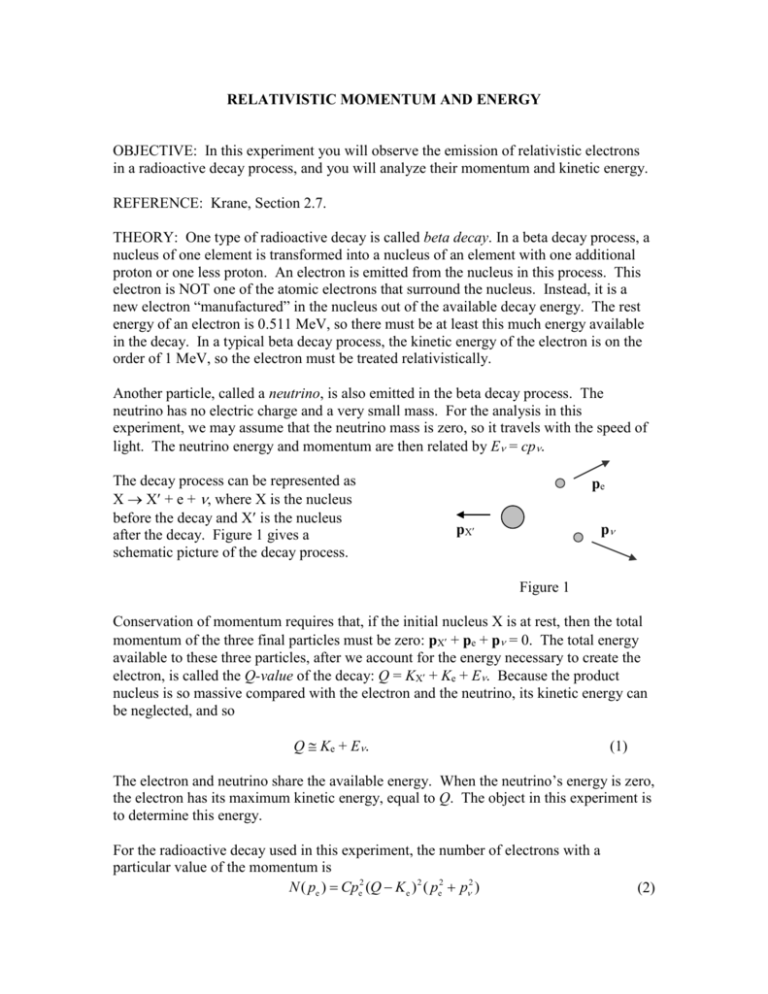
RELATIVISTIC MOMENTUM AND ENERGY OBJECTIVE: In this experiment you will observe the emission of relativistic electrons in a radioactive decay process, and you will analyze their momentum and kinetic energy. REFERENCE: Krane, Section 2.7. THEORY: One type of radioactive decay is called beta decay. In a beta decay process, a nucleus of one element is transformed into a nucleus of an element with one additional proton or one less proton. An electron is emitted from the nucleus in this process. This electron is NOT one of the atomic electrons that surround the nucleus. Instead, it is a new electron “manufactured” in the nucleus out of the available decay energy. The rest energy of an electron is 0.511 MeV, so there must be at least this much energy available in the decay. In a typical beta decay process, the kinetic energy of the electron is on the order of 1 MeV, so the electron must be treated relativistically. Another particle, called a neutrino, is also emitted in the beta decay process. The neutrino has no electric charge and a very small mass. For the analysis in this experiment, we may assume that the neutrino mass is zero, so it travels with the speed of light. The neutrino energy and momentum are then related by E = cp. The decay process can be represented as X X + e + , where X is the nucleus before the decay and X is the nucleus after the decay. Figure 1 gives a schematic picture of the decay process. pe pX p Figure 1 Conservation of momentum requires that, if the initial nucleus X is at rest, then the total momentum of the three final particles must be zero: pX + pe + p = 0. The total energy available to these three particles, after we account for the energy necessary to create the electron, is called the Q-value of the decay: Q = KX + Ke + E. Because the product nucleus is so massive compared with the electron and the neutrino, its kinetic energy can be neglected, and so Q Ke + E. (1) The electron and neutrino share the available energy. When the neutrino’s energy is zero, the electron has its maximum kinetic energy, equal to Q. The object in this experiment is to determine this energy. For the radioactive decay used in this experiment, the number of electrons with a particular value of the momentum is N ( pe ) Cpe2 (Q K e ) 2 ( pe2 p2 ) (2) where C is a constant. Note that N(pe) = 0 when pe = 0, and also N(pe) = 0 when pe has its maximum value, corresponding to Ke = Q. Figure 2 shows a sketch of the behavior of N(pe). Figure 2 Equation 2 is really an equation in a single variable, because Ke is related to pe by Ke Ee mec2 ( pec)2 (mec2 )2 mec2 (3) and p is related to pe by p E Q K e c c (4) Determining the maximum energy or momentum from a plot like Figure 2 is difficult, because it is hard to find exactly where the curve hits the axis at the upper end. It would be easier to use a linear plot, but Equation 2 is not easy to put in linear form. We can approximate linear behavior by writing Equation 2 in the following form: 1/ 2 N( p ) C (Q K e ) 2 2 e 2 pe ( pe p ) (5) If we plot the quantity on the right side of Equation 5 on the y axis as a function of Ke on the x axis, we should get a straight line. Extending the straight line to where it meets the x axis gives the value of Q. This process is kind of circular, because in order to determine the value of the quantity in brackets in Equation 5, we must first know the value of Q (needed to find p from Equation 4). So to determine Q we first must know Q. It turns out that this process is not very sensitive to Q, so we will first make a plot like Figure 2 and estimate the maximum value of pe. We can then use that value to find the maximum value of Ke, which will serve as our estimate for Q. Then we use this estimated value of Q in Equation 4 and make a plot of Equation 5 to determine a better value for Q. Magnet pole Determining the momentum of the electron: When a charged particle moves in a uniform magnetic field, its path is a circular arc. Figure 3 shows a schematic diagram of the apparatus for this experiment. Electrons enter through the collimator at the bottom and pass through a circular aperture into the field region between the poles of the magnet. Varying the current through a coil changes the strength of the field. The electrons move in a circular arc and pass through the second aperture and into a counter. Counter Collimator Source Figure 3 The relation between the field strength and radius is p r e or pe erB eB (6) where all quantities are expressed in SI units (pe in kgm/s, B in tesla = 104 gauss) and e is the magnitude of the charge of the electron (1.602 10-19 C). Equation 6 is correct even when the momentum is relativistic. In using Equations 3,4, and 5, it is often easier to express the momentum in units of MeV/c: 1 MeV/c = 5.33 1022 kgm/s (7) PROCEDURE: 1. Check the alignment of the system – make sure the collimator is directly below the bottom aperture and the counter is directly behind the back aperture. 2. Measure the distance from the back lower corner of the magnet pole to the center of each aperture to determine the radius r of the path of the electron. Estimate the uncertainty in this value. 3. Take data every 0.25 A from 0-4 A. Count for 2 minutes at each value. 4. Remove the source to a distant location and measure the background counts. Take four 2-minute background runs. This background in the detector comes from cosmic rays and from natural radioactivity in the concrete walls and floor. ANALYSIS: 1. Add the four background counts together and determine the uncertainty (the uncertainty in N counts is N ). Divide this number by 4 to get the average background for a 2-minute count and its uncertainty (divide the total uncertainty by 4 also). 2. Subtract the background from each data point. Determine the uncertainty of each background-corrected data point. 3. Plot the background-corrected N(pe) against pe. Show the uncertainties of each point on your graph. From your graph, estimate the maximum momentum of the electrons. From this value, find the estimate of Q. 4. For each data point, determine the electron kinetic energy Ke and the neutrino momentum p. Plot Equation 5 and draw a straight line through the points in the upperenergy region. From the x-intercept of your line, determine the value of Q. Put uncertainties on each data point and try to estimate the uncertainty in Q by drawing lines of the greatest and smallest slope. Your uncertainties in Eq. 5 should include the uncertainties in the quantity on the right side, based on your uncertainties in N and an estimate of the uncertainties in determining pe. There are also uncertainties in Ke originating from the uncertainties in pe. QUESTIONS: 1. The radioactive source used in these experiments is 204Tl, which has a Q-value of 0.765 MeV. Compare your value with this value and account for any differences. 2. Suppose you changed the value of your initial estimate of Q by 10-20%. How would this change affect the values you plot from Equation 5? Consider only points in the upper-energy region. 3. Why do we not use the low-energy points in plotting the straight line from Equation 5? If you extrapolate the line to low energy, do the experimental points fall above the line or below the line? Try to suggest some reasons for this behavior.

